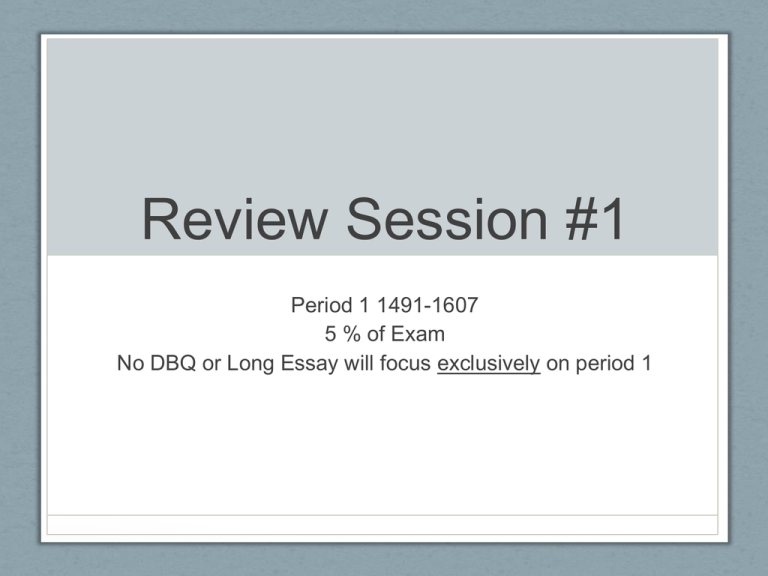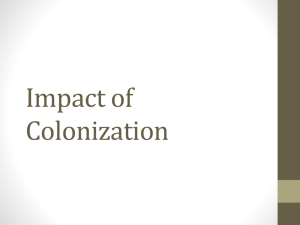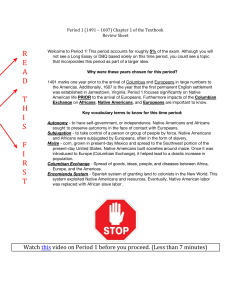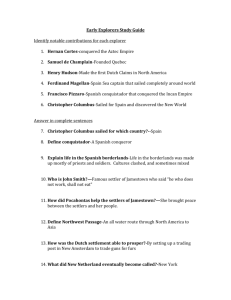Review Session #1
advertisement

Review Session #1 Period 1 1491-1607 5 % of Exam No DBQ or Long Essay will focus exclusively on period 1 Key Concept 1.1 “Before the arrival of Europeans, native populations in North America developed a wide variety of social, political, and economic structures based in part on interactions with the environment and each other.” • Good to know: • Look @ maps of different areas of North America: • How did natives adapt to their environment? • How did different natives interact with each other? Maize (corn) • Specifically mentioned in curriculum framework (might see a direct question about it) • In general maize cultivation • Enlarged populations • Allowed for more permanent living • Natives developed villages around maize The Great Plains/ Plains Area • Great Plains, • Hunting and gathering • Lack of resources • Large flat land • Horses (introduced by Europeans) • Hunting becomes easier (bison) • Warfare becomes more destructive • . Southwest US • In the southwest of North America, tribes tended to settle in one place and practice agriculture (ex. Pueblo people) • Pueblos developed irrigation systems to support maize cultivation Northeast • Mix of hunting/gathering • Many permanent housing structures • farmed the three sisters (maize, beans, and squash), hunted game, and fished in the many rivers, lakes, and the sea • Iroquois- (Present day NY and PA): • Burned forests to hunt and grow crops • Villages were built around maize (corn) • matriarchal society: • Power was based on female authority • Women were instrumental in councils and decision-making • Women would tend to crops and oversaw community affairs while men hunted Iroquois long house Serve as home for extended family or clan All clans traced their heritage back through female ancestors (matriarchy) West • Most based on hunting, gathering, and foraging • Societies tended to be ruled by wealthy families • Chinooks • Advocated warrior traditions • Used advanced fighting techniques • Lived in longhouses which could house many families similar to Iroquois Key Concept 1.2 “European overseas expansion resulted in the Columbian Exchange, a series of interactions and adaptations among societies across the Atlantic.” • Good to know: • Positives and negatives from Columbian exchange • Impact on New and Old Worlds Reasons for exploration • Reasons for European exploration • 3 G’s – God, Gold, & Glory • Spain- spread Christianity • Encomiendas- allowed the government to “commend”, or give, Indians and land to certain colonists in return for the promise to try to Christianize them • It really was slavery. • France- profit – beaver fur in northern America • England- profit • Joint-stock companies- $ raised by selling shares to investors who became partners in the venture Why Explore Now? (1400-1500s) • Technological/scientific innovations (caravel ship, better maps, astrolabe) • Intellectual curiosity and thirst for knowledge, stimulated by the Renaissance • Bigger populations, rebounding after the Black Plague in the Middle Ages • Increase in trade/desire for new trade routes/$$$ • Increased nationalism (pride in country/ethnic group) as nation-states like Spain emerged The “Columbian Exchange” Columbian Exchange refers to the interaction between the “Old World” (Europe) and “New World” (Americas). Americas to Europe: turkeys, pumpkins, corn, tomatoes, peanuts, tobacco, and other goods. Europe to Americas: livestock (including the first horses), grapes, sugar cane, honey bees, and citrus fruits. Europeans also brought diseases including smallpox, malaria, and measles, which wiped out thousands of Native Americans. Within 50 years of Columbus’s landing, only one in 10 Native Americans still survived. Columbian Exchange • Europe • Increase European food consumption and population • Shift from Feudalism to capitalism • Africa • Increase slave trade • Natives • Increase in disease • Drawing from the Florentine Codex showing transmission of smallpox among Natives Key Concept 1.3 “Contact among American Indians, Africans, and Europeans challenged the worldviews of each group.” Good to know: How did Spaniards view/treat natives How did Natives resist European conquest How did Africans adapt to new contact Spanish Contact • “Black Legend”- concept held that the conquerors merely tortured and killed the Indians, stole their gold, infected them with smallpox, and left little but misery behind. • Somewhat true • They grafted their culture, laws, religion, and language into the native societies. This laid the foundation for the modern- day Spanish speaking nations. • The Spanish also incorporated indigenous culture with their own, rather than isolating and shunning the Indians as the English did • Intermarriage • Mestizo-SP and Native • Mulatto- Spanish and African Spanish Contact • Many Spaniards saw themselves as superior to Natives • Tried to impose their religion through missions • Caste system develop • Mestizo • Mulatto • Bartolome de las Casas • argued Natives as equals to SP • Helped end encomienda system • Juan de Sepulveda: • Advocated harsh treatment of Natives • Claimed slavery for Natives was justified under Christianity Adaption/Resistance • Some Native resistance/ tried to preserve their autonomy • Juan de Onate- defeated revolts of Pueblos in New Mexico area • Africans • Maintained native religious elements while mixing them with Christianity • Maroon communities in Brazil and Caribbean- communities of runaway slaves







